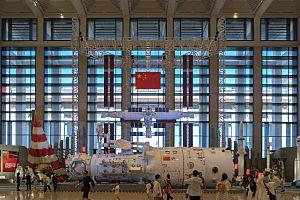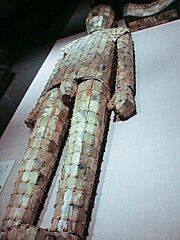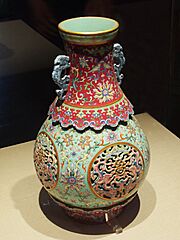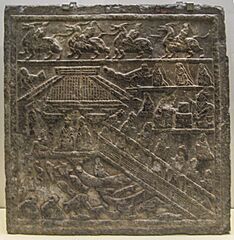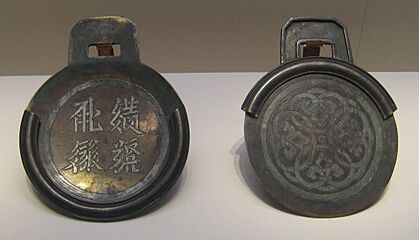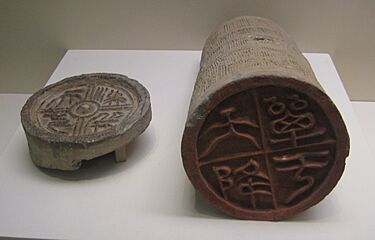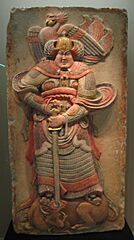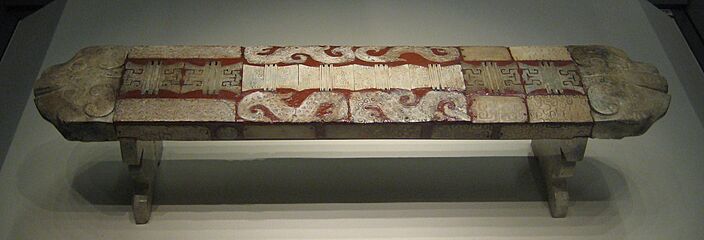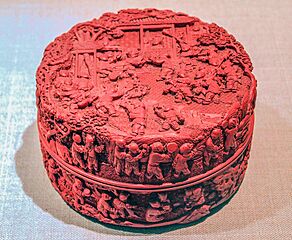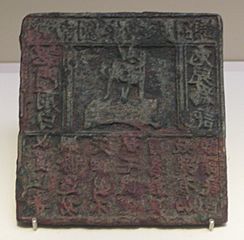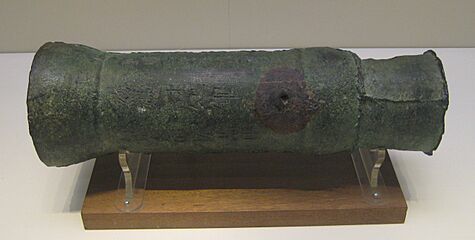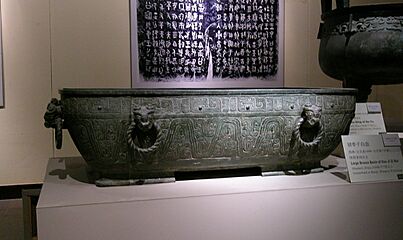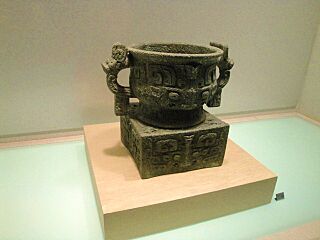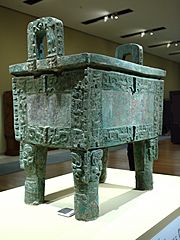National Museum of China facts for kids
| 中国国家博物馆 | |
 |
|
 |
|
| Established | 2003 |
|---|---|
| Location | Beijing |
| Type | Art museum, history museum |
| Collections | Chinese art |
| Collection size | 1.3 million |
| Visitors | 2,377,600 (2021) |
| Owner | Ministry of Culture and Tourism |
| Public transit access | 1 Tian'anmen East |
The National Museum of China is a huge museum in Beijing, China. It's right next to Tiananmen Square. This museum is special because it shows both amazing art and important history from China.
It has a massive building, about 200,000 square meters in size. Inside, you can find more than 1.4 million different items. There are 48 rooms just for exhibitions! It's known as the museum with the biggest single building in the world. It also has the largest collection of Chinese historical treasures. The museum is supported by the Chinese government's Ministry of Culture and Tourism.
History of the Museum
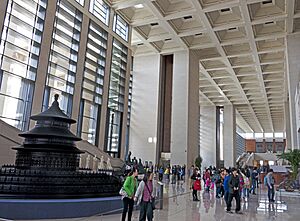
The National Museum of China as we know it today was created in 2003. It was formed by joining two older museums. These two museums had been in the same building since 1959.
One was the Museum of the Chinese Revolution. It started in 1950 to keep the history of the 1949 Chinese Revolution alive. The other was the National Museum of Chinese History. This museum began in 1912 and was focused on protecting China's long history.
The museum building itself was finished in 1959. It was one of the Ten Great Buildings built to celebrate 10 years since the People's Republic of China was founded. It stands opposite the Great Hall of the People, which was built at the same time. The museum building is very large, covering about 6.5 hectares (which is like 16 acres). It is 313 meters long and 40 meters tall, with ten big pillars at the front.
The museum closed for four years for a big renovation. It reopened on March 17, 2011. After the renovation, it had 28 new exhibition halls. This more than tripled the space for showing items. It also got new, modern facilities for displaying and storing its collections. A German company called Gerkan, Marg and Partners designed these changes.
In November 2012, a special exhibit called "Road to Rejuvenation" was held here. China's leader, Xi Jinping, spoke at this exhibit. He talked about the "Chinese Dream," which is about China becoming a strong and successful nation. The exhibit showed how China overcame difficult times in its past. It also highlighted the Chinese Communist Revolution and the founding of modern China. Xi Jinping said that making the Chinese nation strong again was the biggest dream for China in modern times.
Because of the COVID-19 pandemic, the museum was closed for much of 2020. This meant fewer people could visit. However, in 2021, it was still the second most-visited art museum in the world. Only the Louvre Museum in France had more visitors.
Amazing Collections
The museum's collection covers Chinese history from 1.7 million years ago. It goes all the way to the end of the Qing dynasty, which was China's last imperial family. The museum has over 1,050,000 items. Many of these are very rare and special, and you won't find them anywhere else.
Some of the most important items include:
- The "Houmuwu Ding" from the Shang dynasty. This is the heaviest piece of ancient bronze in the world, weighing over 832 kilograms!
- A square bronze container from the Shang dynasty decorated with four sheep heads.
- A large, rare bronze water basin from the Western Zhou dynasty with writing on it.
- A gold-decorated bronze tiger-shaped tally from the Qin dynasty.
- Beautiful Han dynasty jade burial suits sewn with gold thread.
- A large collection of colorful Tang dynasty pottery called sancai.
- Many beautiful ceramics from the Song dynasty.
The museum also has a very important collection of old coins. This includes 15,000 coins given by a collector named Luo Bozhao.
One permanent exhibition is called The Road to Rejuvenation. This show tells the story of China's recent history. It starts from the time of the First Opium War. It focuses on the history of the Chinese Communist Party and its achievements.
You can also see a haycutter that was used by forces to execute a revolutionary hero named Liu Hulan. In 1951, a famous sculpture of Liu was made for the museum. It became a well-known image of her.
The exhibit about Deng Xiaoping's life includes a Stetson hat he received. He got it during a rodeo when he visited the United States in 1979. Pictures of him wearing the hat became very famous.
On April 9, 2021, a new photo exhibition opened at the museum. It was called "Field of Hope: A National Photographic Exhibition on 'Poverty Alleviation and Sharing a Moderately Prosperous Society'." This exhibition showed 180 photos by nearly 150 photographers. It highlighted China's efforts to help people get out of poverty.
Gallery
-
A Han dynasty jade burial suit laced with gold thread at the National Museum of China
-
A pastel pierced porcelain vase, from the Qianlong era of the Qing dynasty
-
Copperplate for printing the Great Ming one string banknote
-
A bronze vessel in the shape of an owl, from the tomb of Lady Fu Hao, from Shang dynasty, 13th century BC
-
Painted stone relief depicting a warrior from the Later Liang dynasty
-
Painted pottery of Neolithic Yangshao culture, with depiction of a stork catching a fish and a stone axe on the side
-
Bronze tallies with inscriptions inlaid in gold from the Warring States period, Chu State
-
Brick relief depicting two scholars and two maids, from the Southern dynasties
-
Bronze plate for printing an advertisement for the Liu family needle shop at Jinan, Song dynasty. The earliest extant example of a commercial advertisement
-
Bronze cannon with inscription dated the 3rd year of the Zhiyuan Era (1332), Yuan dynasty
-
Li gui, the earliest Zhou dynasty bronze vessel to be discovered, and the only epigraphic evidence of the day of the Zhou conquest of Shang
-
Houmuwu Ding, the largest piece of bronze work found in the world so far. It was made in the late Shang dynasty at Anyang
Special Countdown Clocks
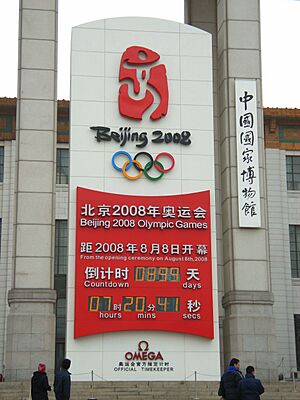
Because the museum is in such an important spot in Tiananmen Square, its front has been used for special countdown clocks. These clocks show how much time is left until big national events.
For example, they counted down to:
- The 1997 return of Hong Kong to China.
- The 1999 return of Macau to China.
- The start of the 2008 Beijing Olympics.
- The opening of the 2010 World Expo in Shanghai.
See also
- List of largest art museums
- List of most visited art museums
- List of museums in China
- Palace Museum
- National Palace Museum
- State Administration of Cultural Heritage
- Ministry of Culture


